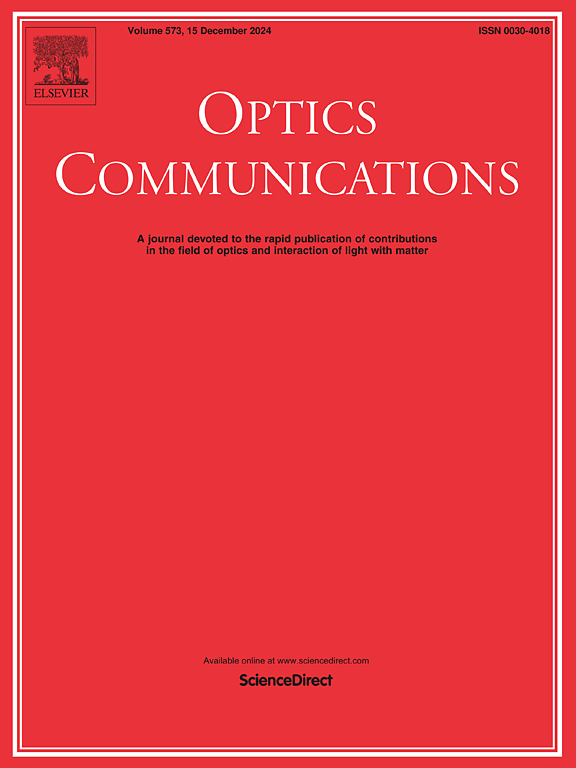Er3+ -doped oxyfluoroborosilicate glass ceramics with embedded CaF2 nanoparticles for 1.53 μm broad band applications
IF 2.2
3区 物理与天体物理
Q2 OPTICS
引用次数: 0
Abstract
The CaF2 based oxyfluoroborosilicate glasses and glass ceramics doped with Er3+ ions were prepared via melt quench process followed by heat treatment and characterized for 1.53 μm broadband applications. The optimized glass ceramic sample was obtained at 450oC/1h heat treatment. The Er3+ concentration was optimized as 1.0 mol% for efficient emission at 460 nm excitation through concentration dependent luminescence analysis. The spectroscopic parameters such as Ωλ = 2,4,6 parameters and the radiative parameters such as spontaneous transition probability rates (AR), branching ratios (βR) and decay times (τR) were calculated applying the standard Judd-Ofelt theory. The effective bandwidth (Δλeff), stimulated emission cross-section (σe), gain bandwidth (σe × Δλeff), quantum efficiency (η) and figure of merit (σe × τR) were calculated as 25.78 nm, 13.42 × 10−21 cm2, 3.46 × 10−26 cm3, 82.83% and 5.32 × 10−23 cm2s, respectively for the optimized glass ceramic sample. The exchange type of energy transfer among the excited Er3+ ions results the quenching in luminescence and the non-exponentiality in decay curves. The systematic investigations carried out indicate that the glass ceramic obtained at 450oC/1h heat treatment was proficient for 1.53 μm broadband fiber lasers and optical amplifiers in S and C band communication window.
用于 1.53 μm 宽带应用的嵌入 CaF2 纳米粒子的掺杂 Er3+ 氧氟硼硅酸盐玻璃陶瓷
通过熔融淬火工艺制备了掺杂有 Er3+ 离子的 CaF2 基氧氟硼硅酸盐玻璃和玻璃陶瓷,然后进行了热处理,并对 1.53 μm 宽带应用进行了表征。优化的玻璃陶瓷样品是在 450oC/1h 热处理条件下获得的。Er3+ 浓度优化为 1.0 摩尔%,通过浓度依赖性发光分析,可在 460 纳米激发波长下高效发射。光谱参数(如 Ωλ = 2、4、6 参数)和辐射参数(如自发转变概率率 (AR)、分支率 (βR) 和衰变时间 (τR))均采用标准的 Judd-Ofelt 理论进行计算。计算出优化玻璃陶瓷样品的有效带宽(Δλeff)、激发发射截面(σe)、增益带宽(σe × Δλeff)、量子效率(η)和优点系数(σe × τR)分别为 25.78 nm、13.42 × 10-21 cm2、3.46 × 10-26 cm3、82.83% 和 5.32 × 10-23 cm2s。激发的 Er3+ 离子之间的交换型能量转移导致了发光淬灭和衰变曲线的非幂等性。系统研究表明,在 450oC/1h 热处理条件下获得的玻璃陶瓷可用于 1.53 μm 宽带光纤激光器和 S、C 波段通信窗口的光放大器。
本文章由计算机程序翻译,如有差异,请以英文原文为准。
求助全文
约1分钟内获得全文
求助全文
来源期刊

Optics Communications
物理-光学
CiteScore
5.10
自引率
8.30%
发文量
681
审稿时长
38 days
期刊介绍:
Optics Communications invites original and timely contributions containing new results in various fields of optics and photonics. The journal considers theoretical and experimental research in areas ranging from the fundamental properties of light to technological applications. Topics covered include classical and quantum optics, optical physics and light-matter interactions, lasers, imaging, guided-wave optics and optical information processing. Manuscripts should offer clear evidence of novelty and significance. Papers concentrating on mathematical and computational issues, with limited connection to optics, are not suitable for publication in the Journal. Similarly, small technical advances, or papers concerned only with engineering applications or issues of materials science fall outside the journal scope.
 求助内容:
求助内容: 应助结果提醒方式:
应助结果提醒方式:


